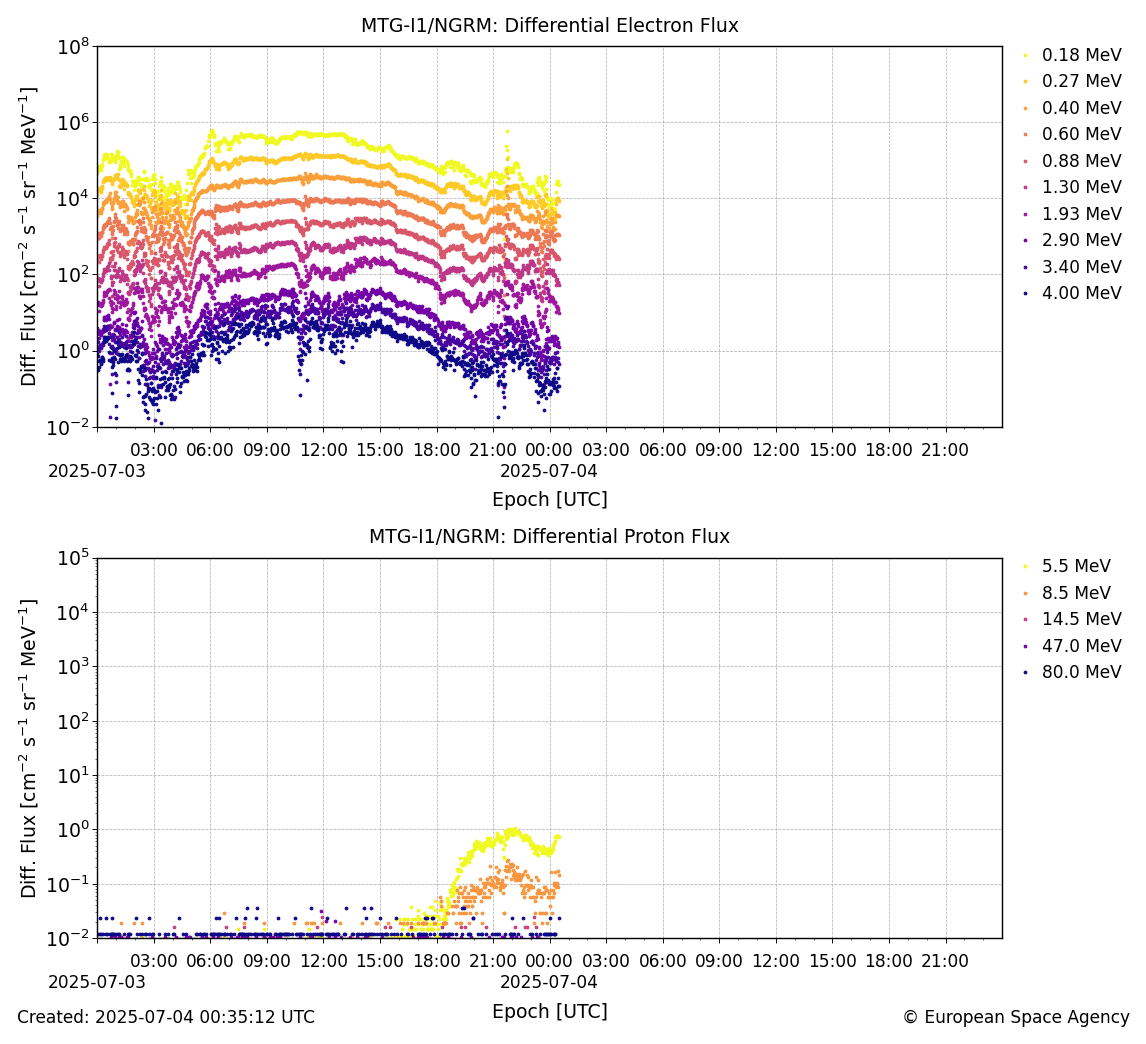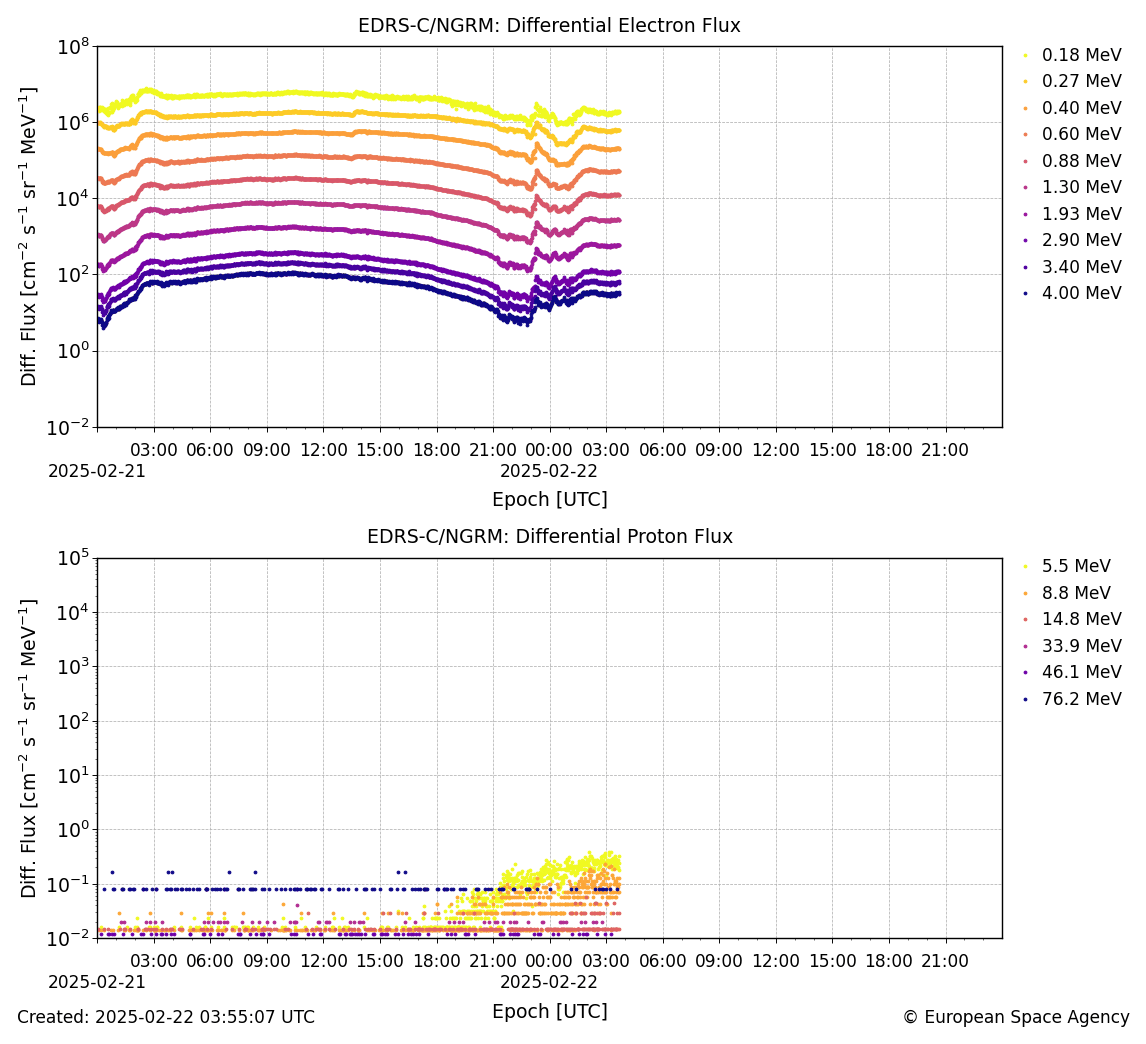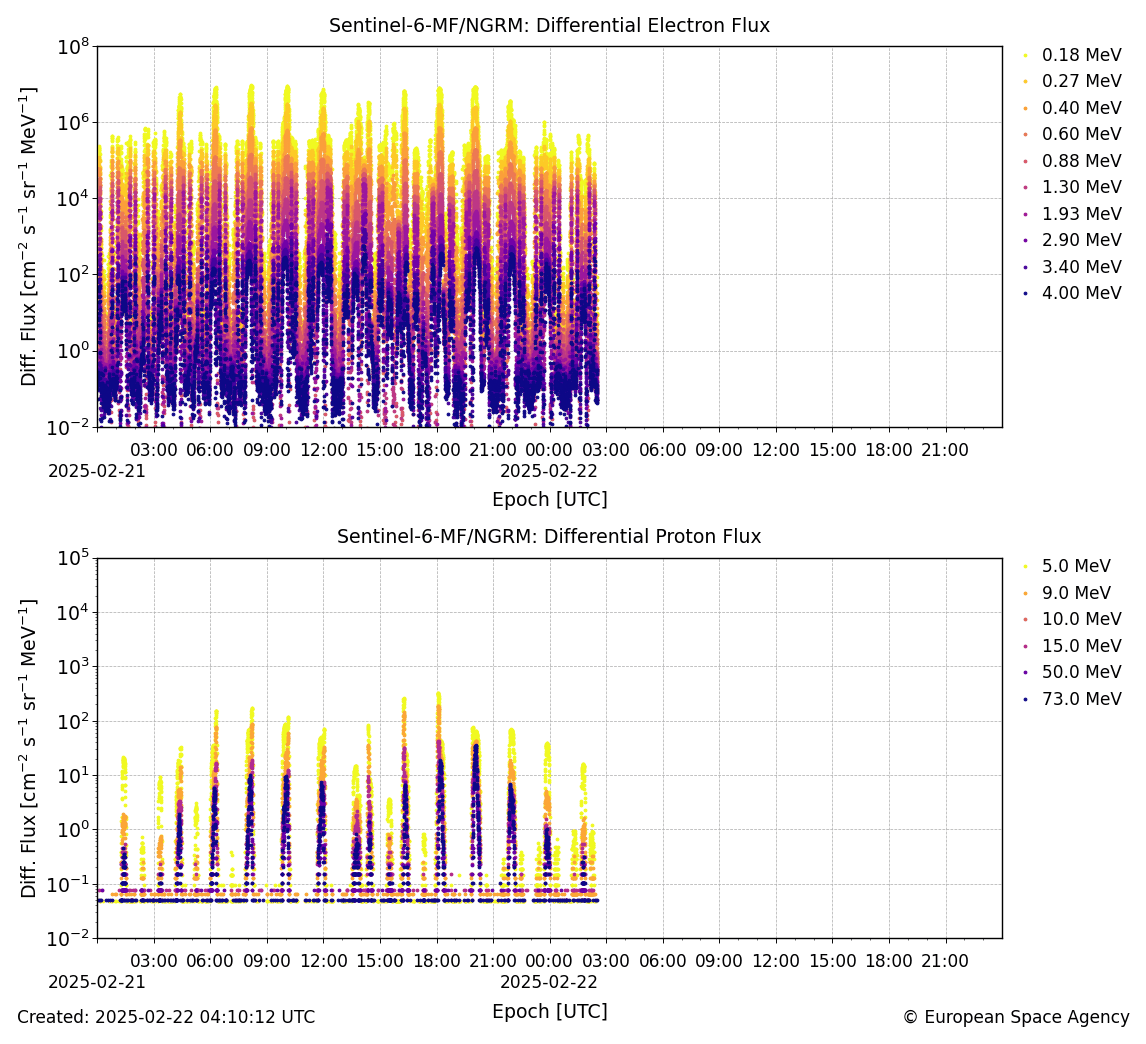NGRM
NGRM - Next Generation Radiation Monitor
NGRM data is provided as part of the SWE Service Network’s General Data Services.
Access it via the SWE Data Browser or through HAPI.
Starting 2025-05-12 the EDRS-C spacecraft has been moved to a new position in geostationary orbit. It arrived at its new location at 142.5° East on 2025-06-15. During the re-location NGRM did not record data.
The Instrument
NGRM is the second Space Weather instrument flying as part of ESA’s Distributed Space weather Sensor System (D3S). The first NGRM unit was placed on the GEO European Data Relay System - C (EDRS-C) spacecraft, the second is hosted on board the Low Earth Orbit (LEO) Sentinel-6 Michael Freilich (S6-MF) and the third one is on board the first GEO Meteosat Third Generation-Imager (MTG-I1).
NGRM entails two particle sensors, the electron detector (ED) consisting of 16 circular silicon strip detectors with a circular step collimator on top, and the stacked detector (SD) comprising an assembly of seven silicon detectors layered with several aluminum and tantalum degraders. Incident charged particles are registered according to the detection logic in one of 16 electron or one of 10 proton channels. [L. Desorgher et al., 2013]
ED and SD have been calibrated with both experimental and numerical means. The electron (proton) response functions (RF) of ED and SD have been derived using 4π-and linear-beam GEANT4 simulations slightly re-adjusted with experimental results based on the unit’s experimental calibrations at the Proton Irradiation and the Electron Monochromator Facilities at Paul Scherrer Institute, Switzerland.
NGRM flux datasets
For the derivation of electron and proton flux products, two different methods have been applied; the Bow-Tie (BT) analysis and the Genetic Correlative Unfolding Method (GenCORUM).
The BT analysis applies to the response functions of the detectors channels and allows the derivation of a scaling factor for the conversion of the detector’s count rates to flux products for an energy value that minimizes the uncertainties expected at the encountered space radiation environment (cf. Sandberg et al 2019)
The GenCORUM [Aminalragia-Giamini et. al 2018] is an artificial intelligence method which employs a Cased-Based Reasoning (CBR) process coupled with a Genetic Algorithm (GA). The CBR process performs an initial crude unfolding taking into account the count-rates measured from all the detector channels simultaneously, and the GA optimizes the resulted flux values.
The characteristics of the provided NGRM Level 1 (L1) flux are provided below. Note that the datasets include also timestamps, ephemeris data (in the ECI coordinate system) and magnetic coordinates (L, L*, MLT etc). The magnetic coordinates were derived using the UNILIB library (accessible here) assuming the IGRF model for the internal, and the quiet Olson-Pfitzer 1977 model for the external magnetic field components.
❗The NGRM datasets are being renamed. The old datasets are deprecated and will be decommissioned with Portal release 3.14. Please use the new dataset names and HAPI identifiers:
- "Sentinel-6-MF/NGRM differential electron fluxes (ESA)"
Identifier: d3s_sentinel6mf_ngrm_science_ep_l1_gc_v1
HAPI identifier: spase://SSA/NumericalData/D3S/d3s_sentinel6mf_ngrm_science_ep_l1_gc_v1- "Sentinel-6-MF/NGRM integral electron and differential proton fluxes (ESA)"
Identifier: d3s_sentinel6mf_ngrm_science_ep_l1_bt_v1
HAPI identifier: spase://SSA/NumericalData/D3S/d3s_sentinel6mf_ngrm_science_ep_l1_bt_v1- "EDRS-C/NGRM differential electron fluxes (ESA)"
Identifier: d3s_edrsc_ngrm_spid204030252_science_ep_l1_gc_v3
HAPI identifier: spase://SSA/NumericalData/D3S/d3s_edrsc_ngrm_spid204030252_science_ep_l1_gc_v3- "EDRS-C/NGRM integral electron and differential proton fluxes (ESA)"
Identifier: d3s_edrsc_ngrm_spid204030252_science_ep_l1_bt_v3
HAPI identifier: spase://SSA/NumericalData/D3S/d3s_edrsc_ngrm_spid204030252_science_ep_l1_bt_v3
GEO MTG-I1/NGRM L1 datasets
The first Meteosat Third Generation-Imager (MTG-I1) satellite was launched on 13 December 2022 into GEO at 0°.
After an extended commissioning period of the satellite and payload, NGRM became operational on 2024-09-10.
The current data release of MTG-I1/NGRM flux Level 1 datasets consists of
- d3s_mtgi1_ngrm_science_ep_l1_gc_v1
which includes proton omnidirectional differential fluxes FPDO[ (cm2 s sr MeV)-1 ] and integral fluxes FEIO[ (cm2 s sr)-1] estimated using simple geometric factors derived with a BT method, and the
- d3s_mtgi1_ngrm_science_ep_l1_bt_v1
which includes electron omnidirectional differential fluxes FEDO[ (cm2 s sr MeV)-1 ] de-convoluted using the GenCORUM. The energy bins and the respective energies [MeV] per particle and spectra type of the provided datasets are given in Table 1
| Energy Bin | FEDO_ENERGY | FEIO_ENERGY | FPDO_ENERGY |
|---|---|---|---|
| 1 | 0.18 | 0.2 | 5.5 |
| 2 | 0.27 | 0.3 | 8.5 |
| 3 | 0.40 | 0.4 | 14.5 |
| 4 | 0.60 | 0.6 | 47 |
| 5 | 0.88 | 1.0 | 80 |
| 6 | 1.30 | 1.1 | - |
| 7 | 1.93 | 1.2 | - |
| 8 | 2.90 | - | - |
| 9 | 3.40 | - | - |
| 10 | 4.00 | - | - |
For more details on the MTG-I1/NGRM data sets, please consult the Data Description Document
LEO S6-MF/NGRM L1 datasets
The Sentinel-6 Michael Freilich (S6-MF) satellite was launched on November 2020 in a LEO with 1336 km orbit altitude and 66° orbit inclination.
The current data release of S6-MF/NGRM flux Level 1 datasets consists of
- d3s_sentinel6mf_ngrm_science_ep_l1_gc_v1
which includes proton omnidirectional differential fluxes FPDO[ (cm2 s sr MeV)-1 ] and integral fluxes FEIO[ (cm2 s sr)-1] estimated using simple geometric factors derived with a BT method, and the
- d3s_sentinel6mf_ngrm_science_ep_l1_bt_v1
which includes electron omnidirectional differential fluxes FEDO[ (cm2 s sr MeV)-1 ] de-convoluted using the GenCORUM. The energy bins and the respective energies [MeV] per particle and spectra type of the provided datasets are given in Table 2
| Energy Bin | FEDO_ENERGY | FEIO_ENERGY | FPDO_ENERGY |
|---|---|---|---|
| 1 | 0.180 | 0.15 | 5.0 |
| 2 | 0.270 | 0.25 | 9.0 |
| 3 | 0.400 | 0.35 | 10 |
| 4 | 0.600 | 0.4 | 15 |
| 5 | 0.880 | 0.5 | 50 |
| 6 | 1.30 | 0.65 | 73 |
| 7 | 1.93 | 0.8 | - |
| 8 | 2.90 | 0.9 | - |
| 9 | 3.40 | 1.0 | - |
| 10 | 4.00 | 1.1 | - |
| 11 | - | 1.2 | - |
| 12 | - | 1.3 | - |
| 13 | - | 1.4 | - |
| 14 | - | 1.5 | - |
| 15 | - | 1.6 | - |
| 16 | - | 1.7 | - |
For more details on the S6-MF/NGRM data sets, please consult the Data Description Document
GEO EDRS-C/NGRM L1 datasets
The EDRS-C spacecraft, launched on August of 2019, was located in GEO at 31° East until 2025-05-12 when it was moved to a new position. As of 2025-06-15, it is located in GEO at 142.5° East. The instrument was switched off during the re-location.
The current data release of EDRS-C/NGRM flux Level 1 datasets consists of
- d3s_edrsc_ngrm_spid204030252_science_ep_l1_bt_v3
which includes proton omnidirectional differential fluxes FPDO[ (cm2 s sr MeV)-1 ] and integral fluxes FEIO[ (cm2 s sr)-1] estimated using simple geometric factors derived with a BT method, and the
- d3s_edrsc_ngrm_spid204030252_science_ep_l1_gc_v3
which includes electron omnidirectional differential fluxes FEDO[ (cm2 s sr MeV)-1 ] de-convoluted using the GenCORUM. The energy bins and the respective energies [MeV] per particle and spectra type of the provided datasets are given in Table 3
| Energy Bin | FEDO_ENERGY | FEIO_ENERGY | FPDO_ENERGY |
|---|---|---|---|
| 1 | 0.180 | 0.209 | 5.5 |
| 2 | 0.270 | 0.235 | 8.8 |
| 3 | 0.400 | 0.286 | 14.8 |
| 4 | 0.600 | 0.338 | 33.9 |
| 5 | 0.880 | 0.455 | 46.1 |
| 6 | 1.30 | 0.594 | 76.2 |
| 7 | 1.93 | 0.736 | - |
| 8 | 2.90 | 0.841 | - |
| 9 | 3.40 | 0.944 | - |
| 10 | 4.00 | 1.043 | - |
| 11 | - | 1.20 | - |
| 12 | - | 1.40 | - |
| 13 | - | 1.60 | - |
| 14 | - | 1.80 | - |
| 15 | - | 2.00 | - |
| 16 | - | 2.20 | - |
For more details on the EDRS-C/NGRM data sets, please consult the Data Description Document
The following paper discusses the released EDRS-C/NGRM data:
I. Sandberg et al., 'First results and analysis from ESA Next Generation Radiation Monitor unit on-board EDRS-C,' in IEEE Transactions on Nuclear Science, doi: 10.1109/TNS.2022.3160108.
The SWE Service Network also provides a series of products based on EDRS-C/NGRM measurements:
Figure 1. Illustration of ESA’s Distributed Space Weather Sensor System concept planned to be realised through hosted payload missions as well as dedicated small satellite missions.
Figure 2. The NGRM flight model with the detector system in the right of the instrument and the data handling and I/F electronics in the left part.
Figure 3. Model of the NGRM electron detector (top) and stacked detector (bottom).


